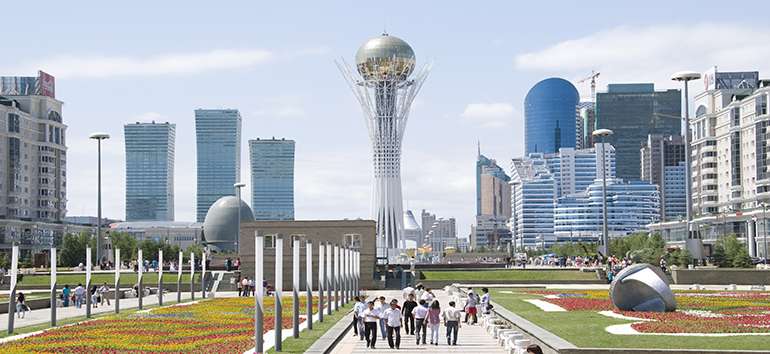ASTANA – Kazakhstan’s economic growth rates will remain low and the impact of the negative environment is intensifying while structural reforms are slowly advancing, according to a recent analysis by the European Bank for Reconstruction and Development (EBRD). The projections for the country’s economic condition in 2016 were reviewed in the EBRD Transition Report for 2015-2016 and regional economic prospects presentation held Jan. 26 in the capital’s Economic Research Institute (ERI). The bank’s leading economists gather at the ERI each year in late January. 
The Kazakh economy has been hit by collapsing oil prices – close to a 70-percent loss since the beginning of 2014 and continued weakening in 2016, said EBRD Associate Director and regional lead economist Dr. Agris Preimanis in his report “Kazakhstan and the Wider Central Asia Region: Heightened Risks.”
In addition, Kazakhstan and the wider Central Asia region are facing a difficult external environment in the form of declining prices for gold, lead, copper, aluminium and gas; the difficult economic outlook in Russia such as continued recession and a collapsing rouble that has lost half its value since 2014 and is continuing to fall as well as challenges in China involving the slowdown of the country’s economic growth and currency weakening of a 6-percent depreciation against the dollar since the beginning of 2016.
Significant stock market volatility is also being observed, as the Shanghai Stock Exchange index lost 15 percent in January 2016 following a 30-percent decline from June to December 2015, according to the report.
“All those factors are new economic realities in which preparing for better times needs to be the main focus,” said Preimanis.
The impulse for growth may come from some external factors such as increasing Chinese investment, slow gradual recovery in commodity prices, the New Silk Road Economic Belt and the Eurasian Economic Union. The key is to ensure better positioning at the time when improvements in external factors materialise, noted his report.
“Perhaps one of those factors will be implemented in the coming three or four years. Kazakhstan needs to get ready in order not to miss this moment and to take advantage of the benefits that one or the other situation will bring,” said Preimanis, according to Forbes Kazakhstan. “To do that, the country needs continued focus on structural reforms, improvement in infrastructure and innovation development in high-tech and low-tech sectors. These will help the country to regain its positions.”
Kazakhstan showed significant progress with reforms such as the new investment law, new exchange rate regime, public-private partnership legislation, tariff reform in regulated sectors, transformation of the Samruk Kazyna Sovereign Wealth Fund and the first steps in establishing the Astana International Financial Centre, according to his report.
Now is the time to press forward, however, because the difficult external environment should not deter reforms, he added.
“Kazakhstan companies are lagging innovation leaders… in the short run, all efforts should go into effective implementation of the President’s reforms under five areas, 100 Concrete Steps, Nurly Zhol programme and other reforms,” the report said.
“Innovation will help to revitalise Kazakhstan’s economy and more innovation is needed as favourable external factors can come in sight at any time and when they do, the economy should be more competitive,” noted the report.
Preimanis announced several projections on the country’s economy as part of his presentation. The country’s growth outlook has been affected. As a result of the plunge in oil prices, recession in Russia and depreciation of the rouble, Kazakhstan’s gross domestic product (GDP) growth decreased to 1.2 percent in 2015 compared to 4.3 percent in 2014.
Considering oil prices will fluctuate between $30-40 per barrel, growth is projected to remain subdued in 2016, reaching only 1.5 percent, while inflation is projected to be 10 percent, indicated the report.
“Given heightened anxiety in the country, realisation of global/regional risks can result in a very different growth outcome in 2016,” it added. Preimanis is certain the impact of negative external factors on Kazakhstan’s economy comes amid anxiety inside the community.
ith the efforts of the country’s National Bank, inflation can be expected to return to the 6-8 percent corridor after 2016 and even lower levels in the longer term, he said.
According to EBRD Country Director for Kazakhstan Janet Heckman, the bank more than doubled its activity in the nation.
“2014 was a record year, but 2015 broke those records and was an excellent year for EBRD in the country,” she noted during the presentation.
The bank financed more than 30 projects across all sectors of the economy, including small and medium businesses, energy efficiency, climate change mitigation, municipal and regional infrastructure and agribusiness.
“Our investment was more than a billion dollars last year… Together with your government, we invested in changing the lives in some 10 cities across Kazakhstan through safer water, better waste water services and modern, accessible and clean public transport,” Heckman said.
“Particularly exciting was the Kazakhstan launch of our Women in Business programme in November (2015), which provides women-led companies with funding through local banks and also advisory services. This programme was the first of its kind in Central Asia; at least around 2,000 Kazakh small and medium enterprises are expected to benefit from it,” said Heckman.
In general, EBRD’s small business support programme concluded 203 consulting projects for SMEs (small and medium-sized enterprises), with funding coming primarily from the government.
